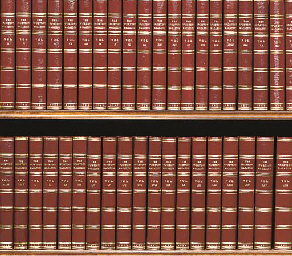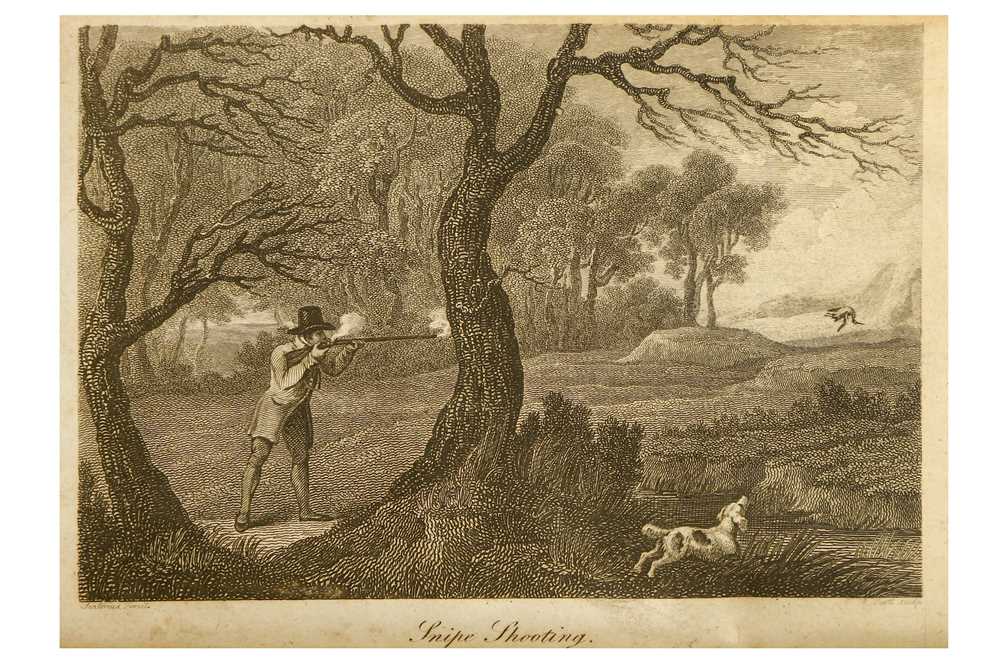The Sporting Magazine and New Sporting Magazine the former London: John Wheble [and others], 1793-1863, volumes 1-142, the latter, London: Baldwin & Cradock [and others], 1831-1844, volumes 1-27 (vol. 26 lacking), each presented in an armorial binding for Henry Arthur Johnstone, of full tan pigskin with double-stitched edges, the front board gilt-embossed with crossed sword and horseshoe escutcheon monogrammed "HAJ", with a horse and jockey flanked by fox faces above and the date of each volume below, the spine with gilt lettering and decoration; fox face, running hare and horseshoes, (seventeen volumes with no stitching or front board decoration, one with single horseshoe on spine), with leather endpapers, the free front endpaper embossed with Johnstone's bookplate (a ship), his name and the date "1899", the inside front board with later bookplate of Howard Gould, the top edges cut and gilt. 168 books total each 8-1/8" x 5-1/4" to 8-5/8" x 5-5/8" Notes: Spanning the late Georgian to the High Victorian era, no periodical better illustrated the recreations of English landed gentry than The Sporting Magazine. It was the first periodical devoted exclusively to sportsmanship, but its focus and features would evolve over the near-century of its publication. Early issues are devoted primarily to the Sport of Kings and other pastimes of the nobility (the regular column "Affairs of Honour" reported on the outcome of duels), but by the 1820s the focus has shifted to the estates of the landed gentry: fox-hunting, fishing, game-shooting. The staff addition of Welsh Charles James Appleby (pen name Nimrod) proved a boon to the periodical, benefiting from his wide network of colleagues and contributors, giving the magazine a tone both authoritative and chummy. The series is a record of laws and mores of the time, not the least of which was a fairly consistent anti-cruelty stance and would eventually gain the patronage and sponsorship of Prince Albert. Each issue was extensively illustrated with engravings, including the works of prominent artists such as the Herrings, Henry Alken George Stubbs and George Morland The magazine's chief competitor was New Sporting Magazine, founded in 1831 by Northumbrian Robert Smith Surtees (1805-1864), a lawyer until 1838 when he inherited the family estate, which allowed him to pursue his singular passion of riding to hounds. (He even gave up editorship of the magazine, though he would continue as a contributor; his Mr. Jorrocks, the cockney grocer obsessed with fox hunting, is one of the great comic characters of English literature.) The two magazines were merged in 1855, and continued publication until 1870. The industrial age had shifted economic focus from the countryside to the big cities, and the emerging middle class found new lawn sports and other leisure activities for their amusement. The magnificent bindings of Henry Arthur Johnstone are well-known; examples are conserved at both the Folger Shakespeare Library and the University of Toronto collection of British Armorial Bindings. The library was sold en bloc in 1921 to British bibliopole H.J.B. Clements, and occasional volumes from Johnstone's library (primarily natural history and sporting works, but also classics, popular novels and histories) still surface on the market from time to time, all with the same distinctive binding. It is surprising then that so little is known of Johnstone himself. He is very likely the Henry Arthur Johnstone born in 1861 and baptized at Christ Church, Camden on September 9, 1863, the son of William David and Harriet Johnstone. The elder Johnstone was a maker of surgical instruments, and his son followed him in this trade. He married, on August 1, 1880, Harriet Pimlett, and the couple had five children. The 1901 census - two years after these bindings were made - show the family at 28 Tysoe Street, an affluent upper middle class address on Wilmington Square, Clerkenwell. Johnstone retired sometime between the mar
The Sporting Magazine and New Sporting Magazine the former London: John Wheble [and others], 1793-1863, volumes 1-142, the latter, London: Baldwin & Cradock [and others], 1831-1844, volumes 1-27 (vol. 26 lacking), each presented in an armorial binding for Henry Arthur Johnstone, of full tan pigskin with double-stitched edges, the front board gilt-embossed with crossed sword and horseshoe escutcheon monogrammed "HAJ", with a horse and jockey flanked by fox faces above and the date of each volume below, the spine with gilt lettering and decoration; fox face, running hare and horseshoes, (seventeen volumes with no stitching or front board decoration, one with single horseshoe on spine), with leather endpapers, the free front endpaper embossed with Johnstone's bookplate (a ship), his name and the date "1899", the inside front board with later bookplate of Howard Gould, the top edges cut and gilt. 168 books total each 8-1/8" x 5-1/4" to 8-5/8" x 5-5/8" Notes: Spanning the late Georgian to the High Victorian era, no periodical better illustrated the recreations of English landed gentry than The Sporting Magazine. It was the first periodical devoted exclusively to sportsmanship, but its focus and features would evolve over the near-century of its publication. Early issues are devoted primarily to the Sport of Kings and other pastimes of the nobility (the regular column "Affairs of Honour" reported on the outcome of duels), but by the 1820s the focus has shifted to the estates of the landed gentry: fox-hunting, fishing, game-shooting. The staff addition of Welsh Charles James Appleby (pen name Nimrod) proved a boon to the periodical, benefiting from his wide network of colleagues and contributors, giving the magazine a tone both authoritative and chummy. The series is a record of laws and mores of the time, not the least of which was a fairly consistent anti-cruelty stance and would eventually gain the patronage and sponsorship of Prince Albert. Each issue was extensively illustrated with engravings, including the works of prominent artists such as the Herrings, Henry Alken George Stubbs and George Morland The magazine's chief competitor was New Sporting Magazine, founded in 1831 by Northumbrian Robert Smith Surtees (1805-1864), a lawyer until 1838 when he inherited the family estate, which allowed him to pursue his singular passion of riding to hounds. (He even gave up editorship of the magazine, though he would continue as a contributor; his Mr. Jorrocks, the cockney grocer obsessed with fox hunting, is one of the great comic characters of English literature.) The two magazines were merged in 1855, and continued publication until 1870. The industrial age had shifted economic focus from the countryside to the big cities, and the emerging middle class found new lawn sports and other leisure activities for their amusement. The magnificent bindings of Henry Arthur Johnstone are well-known; examples are conserved at both the Folger Shakespeare Library and the University of Toronto collection of British Armorial Bindings. The library was sold en bloc in 1921 to British bibliopole H.J.B. Clements, and occasional volumes from Johnstone's library (primarily natural history and sporting works, but also classics, popular novels and histories) still surface on the market from time to time, all with the same distinctive binding. It is surprising then that so little is known of Johnstone himself. He is very likely the Henry Arthur Johnstone born in 1861 and baptized at Christ Church, Camden on September 9, 1863, the son of William David and Harriet Johnstone. The elder Johnstone was a maker of surgical instruments, and his son followed him in this trade. He married, on August 1, 1880, Harriet Pimlett, and the couple had five children. The 1901 census - two years after these bindings were made - show the family at 28 Tysoe Street, an affluent upper middle class address on Wilmington Square, Clerkenwell. Johnstone retired sometime between the mar















Try LotSearch and its premium features for 7 days - without any costs!
Be notified automatically about new items in upcoming auctions.
Create an alert